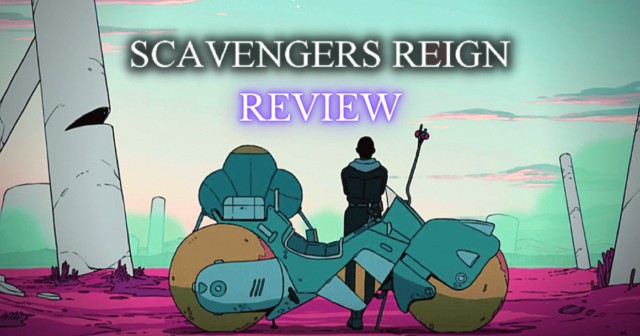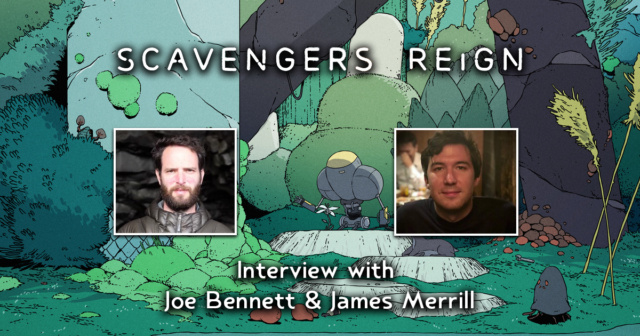Exclusive Interview: Sean Buckelew & Benjy Brooke of ‘Scavengers Reign’
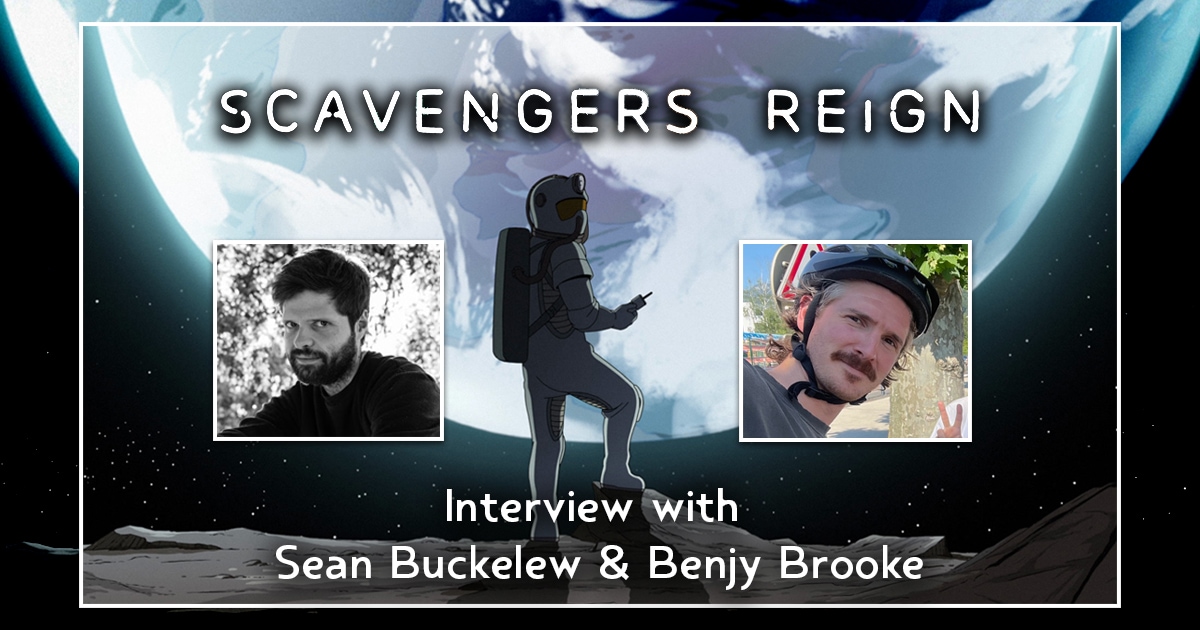
Scavengers Reign ended last week with an incredible season finale, “The Reunion,” full of potential for another season, more jaw-dropping animation, and deeply rich stories. Set on the treacherous alien planet Vesta Minor, the MAX original animated show follows the survivors of the Demeter, a cargo freighter that has shipwrecked in space. The survivors have to navigate life on the planet, where the flora and complex ecological systems on it are not exactly friendly about their incursion.
Scavengers Reign is a stunningly animated sci-fi horror trip into a lush and terrifying world. The team that brought it to life took us on a beautiful and visceral journey that’s deeply immersive You can check out Anthony Flagg’s review of the series here.
In late October, we sat down over Zoom for an exclusive interview with Sean Buckelew and Benjy Brooke to talk about the groundbreaking show.
The interview with Sean Buckelew & Benjy Brooke of Scavengers Reign
[Editor’s Note: There are spoilers ahead for Scavengers Reign. This interview has been lightly edited for clarity.]
Ayla Ruby: “Okay, so I guess I’ll just jump right into it. So this was a short that was on Adult Swim. Can you guys talk about the process from 2016 to now, to a full season, because obviously, 12 episodes are very different than a short. And how you guys got onto the project?”
Sean Buckelew: “Yeah, I mean, I was there when Joe [Bennett] came by my studio and was like, check out this animatic for this short, I’m working on, Charles [Huettner] and I had a podcast together. We were friends from other projects, and it just looked great. So I helped out a little bit on the short, but more just as a fan, I was like, I can animate a scene or two just because I think this thing is great.”
“And I think, I mean my understanding of it, and I don’t want to speak out of turn on Joe’s behalf, but my understanding of it was that it was a pretty low budget, low stakes short, I think from Adult Swim. And so there was just a feeling of they were kind of making it while nobody was watching and then suddenly had the completed short. And it was kind of, I think a lot more ambitious and a lot stranger and bigger than anyone would’ve predicted, but everyone really responded positively to it.”
“So they aired it on Toonami. And I think that then it opened up a conversation about making a pilot. And I would say that like probably a lot of other TV development things, it went in stops and starts of, we made the pilot, but then trying to find a place for where the show fits in or even what the show is about. So then it’s a little bit more of a pitch process of, “Well, here’s the pilot, but what is the whole season?” And then that, let’s write a few more scripts and blah, blah, blah. But then I would say it was about two years ago that we got the full green light to ramp up and staff it.”
“And then Benjy, I guess I knew your work for a long time and everyone had known Benjy’s work, and he was on the top of our list of someone we wanted to bring in on the series. And we had just worked together on Benjy… Animation directed, is that right?”
Benjy Brooke: “Yeah.”
Sean Buckelew: “On a Love Death and Robots episode [“Kill Team Kill” (2022)]. That’s really fantastic, from the third season. And just seeing how his process for doing that was something that we were like, we have to emulate this exactly. He had just cracked the code completely on how to do something that was utilizing a certain kind of pool of talent and just approaching it in a way that felt very bespoke and just a real attention to detail and quality. So yeah, it was…”
Benjy Brooke: “Well, it’s really similar to how Sean and Joe were operating on the short and really in all your projects prior to this and all Sean’s short films, which is just finding artists online on Instagram specifically that we really like, bringing everybody together, a really international pool of artists.”
“And now at this point, it’s this collective that is almost like a hundred artists strong that we’ve been putting on “Kill Team Kill”, Love, Death and Robots to Scavengers to now Common Side Effects. And everybody works like this finely tuned machine and has this, everyone’s so ambitious and so sensitive as artists. And so we’re able to do things… Like these scripts are so ambitious and the artists have such talent, a really amazing, amazing pool that we couldn’t do…”
Sean Buckelew: “Yeah, and to that point, I would just say that when we were originally kind coming up with who we wanted to work on the show, it was people who had really not worked in TV before. I think none of our directors had ever directed TV before, but we knew them as really interesting artists or filmmakers that we had a hundred percent faith that these people are going to do an incredible thing when given the opportunity at this scale.”
“But also just I think we’re coming out of a different universe because that’s where we were coming out of. I mean, I’d never worked on a TV show prior to this, so it was like, you don’t know what you don’t know for better and for worse maybe.”
Benjy Brooke: “Yeah. And Joe and Charles as leaders on this, they’re always pushing for the unexpected and the left of center. I think we are all really allergic to doing something that feels like we’re quoting from something else. And pulling from a pool of artists that are coming from an outside indie animation perspective, it just creates this hotbed of creativity that new things are constantly bubbling up and new ways of looking at old problems are constantly being presented, which is really exciting every time we’re putting a scene together.”
On what was challenging to bring to life for Scavengers Reign
Ayla Ruby: “Was there anything, given that you had all these directors new to television, you had a lot of people, was there anything about the season that was really challenging or really gratifying just to pull off and make happen? Any sequence, anything like that?”
Benjy Brooke: “I would say almost everything was challenging.”
Sean Buckelew: “Definitely everything was challenging. I mean, the challenge was the fun of it. I think that’s what made it all so gratifying in the end was how hard everyone worked towards something so enigmatic. The goal was so strange, and when it worked, it was magic that it could work like that.”
“And the challenging thing was always Joe and Charles looking at work and saying, this doesn’t… If it didn’t hit the tone of the show or that specific enigmatic quality then we needed to work extra hard to push it towards that. But having that guidepost was always extremely valuable. It was just always… And as we got further into the season, all the artists downloaded that sensibility and it became a lot easier. But also the ambition.”
Benjy Brooke: “Yeah, once you know what people can do, the bar goes up and it’s also somebody sets the bar at a certain level kind of outside of our control of just an animator comes in and does something that’s incredible, and everybody sees it and goes, ‘Oh, okay, this is what we’re trying to do here.'”
“And I would also say, like… I said, everything is challenging. I felt like there were so many moments of joy, but it just went through, I think stops and starts of, I would say there was a prevailing feeling of… Near the end of every bit of the process, there was a feeling of ‘This is so fucked, how’s it going to come together into a show we all love?!'”
“And then consistently every time when it did that was… And at different stages, but when each episode actually wrapped, it was like, you’re two weeks out from wrap and you’re going, the last episode was great, and this is the one that sucks. And then it’s like Nic Snyder’s music comes in and the sound comes in, and these last bits of color animation that are kind of the shots in the episodes that you think about after it’s done come in and then you go, ‘Oh, it happened again, and I’m happy about it again’.”
Sean Buckelew: “Best one we’ve ever made. Yeah.”
Benjy Brooke: “Yeah. And then Monday morning it starts all over again. And I’d also say that there were things I think on this show that could have been really challenging because for example, working with Max and working with the network, that they were so supportive I think of moments where if people weren’t really on our wavelength would’ve just been like, ‘Yeah, your second script is a disaster and it makes no sense, and it’s a word jungle..”
“But I felt like there was a lot of faith and I don’t know, we just had great partners at Max who I think were really helping us do what we wanted and just good supports and had a keen eye, I think, for what worked and didn’t work. So I don’t know, that part of it could have been, I think, tricky and was super smooth and amazing from our side.”
Sean Buckelew: “And having the short film and then the pilot episode that achieved such a weird bar of bizarreness, it allowed, I think a lot of the notes we got, they were questioning the strange decisions we were making because it was like oh, strange decisions actually amount to something really interesting. And so go for it. Be as weird as possible.”
Benjy Brooke: “Right. Yeah, when we say it’s kind of like they’re going back in the womb, they go, ‘We love it’.”
Sean Buckelew: “That was great.”
Benjy Brooke: “Yeah. Cool.”
On the corpse flower inspirations for Ursula and the bushwall in Episode 3
Ayla Ruby: “Okay, so kind of related to that, but I want to ask about two things. First I want to ask about, so in episode three, there’s Ursula and there’s this flower, and it’s like pollinate… It’s really cool.”
Benjy Brooke: “Yeah.”
Ayla Ruby: “Just even from an art perspective, not to mention everything else. And I was wondering if you guys could talk about what it took to bring that to life. What was the thought behind it because it’s just really cool.”
Sean Buckelew: “Well, when we were writing that scene, I think there was a lot of inspiration from… I think actually the corpse flower was on display at the Huntington Gardens. So that was on our mind, just the idea of a flower that sprouts once every a hundred years, just this idea of a rarity in nature. And then I think we were also thinking about coral reefs and just a thing that would be a living thing. I don’t know if it’s a plant or a creature, but a living thing that basically encases this kind of miraculous process that happens once every whatever.”
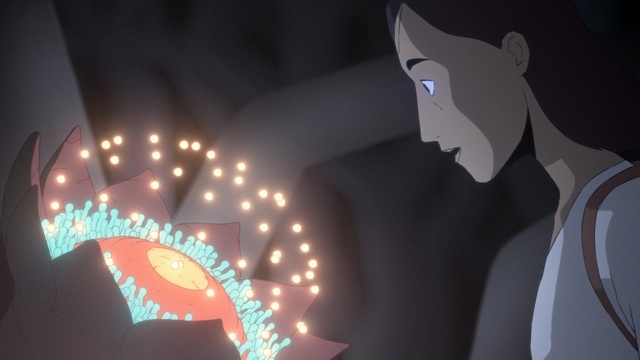
“And obviously none of this is explained, but having some element of that as kind of like, “Oh, this creature lives and dies in 30 seconds and does this little process that’s essential to the propagation of this big coral reef wall.” And then I think also, I mean the inspiration, we talked a lot about human perception, adding this element of mysticalness or inexplicable, whatever…”
“We talked a lot about early man experiencing an Aurora Borealis and just how would you understand what that is and that it would guide you towards a kind of spiritual or religious impulse just because it’s a dazzling, inexplicable, natural phenomenon that you could explain, but whatever. So that was the origin point.”
“And then, I mean, I would shout out Vincent Sweeney and under Benjy’s direction that it was on the page a little bit, and Vincent, the episode director, I think really made it what it is. It would’ve been really shitty without him.”
Benjy Brooke: “And that idea was a kernel of an idea that was in the short film too. There’s a lot of it in there. Beautifully said, Sean, I don’t really have anything else to add, but what’s so cool about that episode is that there’s a lot of, I mean, I don’t want to spoil it for everybody, but there’s a lot of Easter eggs about how that thing… All the processes that lead to that, we have code names for these creatures, but the worm guy eating the fruit, then the bird creature scoops up the worm guy, goes up the tree, feeds it to the reflector birds, they all eat it together.”
“Then the bird guy falls, and then when the bird guy dies, the coral starts to grow from it, and then it becomes the giant nest that this little guy, the flower guy comes from. And it’s this big, big elaborate thing for something so poetic and just this little microcosm of a life at the very end of it. I don’t know. It really tickled me that these guys came up with something that… It touches you on a wavelength that I don’t think you expect science fiction to do.”
On Levi and how the AI is doing at the midpoint of the series
Ayla Ruby: “Well. So it’s not just that scene. There are so many emotional moments just through the whole series and even in the last episode. So I want to talk about Levi because it was very sad. And also you mentioned poetic, and I think that’s kind of a great way to describe what happened to him. Can you talk about that? Can you talk about if it’s going to affect Azi going forward, what it means for Kamen? There’s a lot happening there.”
Benjy Brooke: “Yeah. I mean, it’s funny because I think that… I would credit Joe for a lot of, he just, where I feel like we can sometimes go in the weeds on talking about Neanderthals experiencing the Aurora Borealis. I think Joe thinks in these very primordial emotional… He’s a really big fan of Last of the Mohicans in which we have a little… Early on, Joe edited together this little inspiration reel that was kind of 10 minutes of just like, here’s a scene from, There Will Be Blood, that cold open of him down in the cave. That’s a tone reference. But then it’s the scene in Last of the Mohicans where one of the sisters jumps off the cliff and it’s just so big and dramatic, and Michael Mann-y, but kind of like him going, I don’t know where, but we got to have a thing kind of like this.”
Ayla Ruby: “And you had it. That was…”
Benjy Brooke: “Yeah.”
Ayla Ruby: “Azi off a cliff.”
Benjy Brooke: “Right, and I feel like it’s leaning into just, let’s make this really… I might be a little bit scared to have just a character going like ‘Levi!’ But it’s like, oh, it’s my favorite part of probably the first six episodes is that scene. But I don’t know. I think it was trying to come up with weaving and also it was a big moment for the long con of when are these storylines going to actually intersect?”
“That was just fun to tease out until episode six, I would say. And then by the time you get together, it’s funny, we would show that clip to people when they would come visit the office, and then you’d have to go like, ‘Okay, so this guy’s living in the body, but it’s like he’s sort of in his mom’s basement because he can’t deal with the grief of accidentally killing his ex-wife. But hold on, his wife’s voice is also the voice of the robot.’ It’s sort of like a soap opera if I say this out loud. But I think it was just trying to…”
“I forget what the original question was. God, I’ve gone off the rails.”
“But I guess it’s, in terms of story, I felt like it was, I certainly think it’s setting up Azi to, if she kind of went through this arc in the first six episodes of having to contend with the planet through this kind of mounting consciousness of Levi and then them feeling like they were getting sort of more… If at first, it was like I’m pushing around a Boston Dynamics robot. Now it feels a little bit more like, this is my friend who can feel things and experience things and has this kind of autonomous psychology…”
Sean Buckelew: “And is my guide for the planet.”
Benjy Brooke: “Right.”
Sean Buckelew: “My spiritual guide for the planet and now I’m lost in the desert.”
Benjy Brooke: “Yeah. But I don’t want to… Well, but it’s a good thing she sent that last transmission. For help.”
Sean Buckelew: “Yeah.”
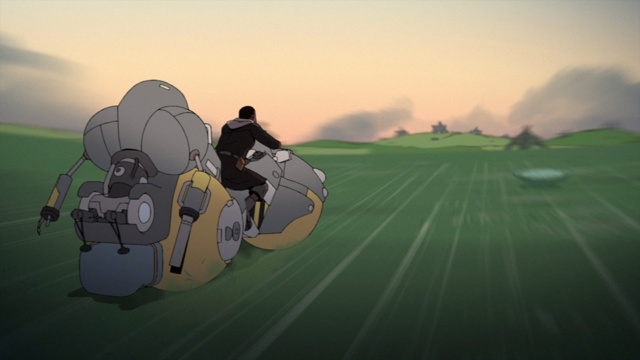
Benjy Brooke: “But yeah, I would say that Azi’s path in that last episode is kind of the most impacted by that interaction.”
Sean Buckelew: “And it creates this, I mean you’ll see this later on, but this is the central… There’s more to come but the central conflict and antagonism, it’s just a great… You have a little bit of an inkling that Azi and Kamen have beef already, but now they, and she doesn’t really understand how Kamen fits into the belly of this creature like what does that mean? But that this becomes the big conflict of the…”
Benjy Brooke: “Yeah.”
On the creature design process for the animals of Scavengers Reign
Ayla Ruby: “So you mentioned earlier that there were, and I don’t know how we’re doing on time, but code names for the creatures. And I’m just… They’re all very fantastical and I’m curious what is the creature design process like for them? Because some of them are just… You know the thing on Sam’s arm that was kind of eating his arm, for lack of a better term, the purple thing. And then there are these other squishy creatures. How do you come up, what’s that process like?”
Sean Buckelew: “I would say in the writing, it usually starts with there’s… We had code names, but we came up with code names because it was always like, this is an ostrich mixed with whatever. And because these creatures come up so much, it’s like you just needed a shorthand because you couldn’t just say… But for example, I would say the little balls in episode two, the little balls that go into the snail creatures, it’s like we talked about snails a lot, but then for the balls, we just called them beach balls.”
Sean Buckelew: “At one point those had… You could see an embryo in them, but we decided to make them more opaque. But there was a design where you could see the little nugget of the creature that they would eventually become.”
Benjy Brooke: “Yeah.”
On biology and ecology as the method behind their design
Sean Buckelew: “We were thinking as much as we could about actual ecology, and biology, and what the purpose of this creature is in the ecosystem. And Joe always said, you can’t really invent anything weirder than what’s already on earth, especially in the deep sea. I was just reading about, I mean, octopus… Everyone’s thinking about octopus right now, but 600 million years ago, we branched off from octopuses from a little worm and have eyes that are very similar to human eyes. So it is very plausible that there will be creatures on other planets that have human-like eyes or animal-like physiognomy.”
Benjy Brooke: “Yeah. And I would say that also we had this amazing artist, Caleb Wood, who is someone we’ve worked with for a long time who was doing pre-design and just coming up with all sorts of plants and creatures and stuff. But also, just because this is on my mind a little anecdote that on the pilot at the very end, we brought on this artist named Nelson Boles who just did a pass-over completed animation of just adding in little guys.”
“So I think the one that I like the most is its kind of an innocuous shot of Sam and Ursula going down into this cave, but you see these two crabs in the corner, crab-like things fighting over a rock, and then one hits the other on the head with a rock and then walks away, and it’s such a quick blink and you’ll miss it moment. But basically just like this one artist who just was coming up with these designs, would come up with the design, how it moved in a unique way and was just peppering them through the episode. And it’s like, I think that also just because it happened so early set this precedent of just put little guys all over the place.”
Sean Buckelew: “Well, I think that’s also… We were all obsessed with [Hayao] Miyazaki forever. And what’s so amazing about Miyazaki is the attention to detail and the ambition level. Sean and I just saw the new one and just the way that the bird moves in, The Boy and the Heron, and the crazy motion of all these churning animals moving together. And I think we’re all thinking about that whenever we’re putting together a world like this. Nausicaä was a big reference point, but just this feeling like artists thinking about a world and how do you make a world feel alive and in the most ambitious way possible.”
Ayla Ruby: “Awesome. Well, thank you both so much. It was lovely talking and I can’t wait to see the rest of the show.”
How to watch Scavengers Reign
Scavengers Reign is now streaming on Max. Have you watched it yet? Or do you plan to? Let us know on social media @mycosmiccircus or come have a chat in The Cosmic Circus Discord.
Scavengers Reign Review: A Disturbing and Beautiful Animation Achievement
Exclusive Interview: Joe Bennett and James Merrill talk Scavengers Reign

